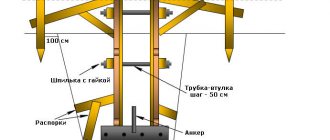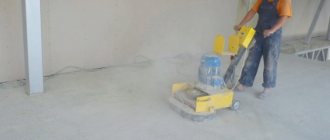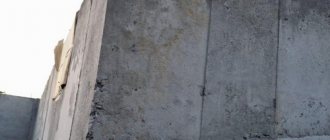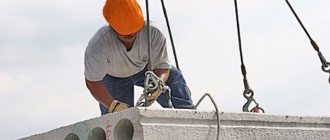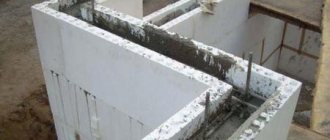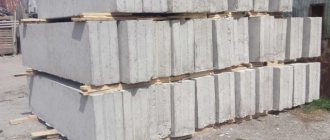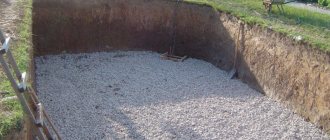It is important for every builder to know exactly when to remove the formwork after pouring concrete. Experienced concrete masters make everything simple: when the concrete can be walked on, then the formwork can be removed. But this method of checking the strength of the foundation is completely unsuitable for the average person. An experienced master feels concrete due to his experience. At home, it is important for a person to know the exact numbers that will tell you when to remove the formwork.
Return to contents
Average hardening time of the solution
After concreting, you need to wait 28 days until the foundation completely hardens. Starting from day 29, construction work on laying thermal insulation or cladding is carried out. Removal of formwork is allowed earlier, depending on the parameters:
- size and type of design;
- concrete grade;
- air temperature (season);
- load size;
- other conditions.
Each case is considered individually. Thus, in summer the formwork is dismantled earlier than in winter.
When determining the hardening time of the foundation, the fundamental point is the type of concrete. The higher the grade, the faster its maturation occurs. In summer, the structure can be removed 7-10 days after pouring concrete .
How best to dismantle formwork
After the concrete has reached the required grade strength, you can begin dismantling the formwork. Most builders remove it in stages, doing the exact opposite of what they did when installing it. But here, too, you need to remember that the use of any construction equipment is prohibited, as is the use of large mechanical forces. After all, you cannot damage the base structure, so in such cases it is better to dismantle the formwork slowly but efficiently, no matter how much time it takes.
The formwork should be removed only after the concrete has reached its original strength, although some builders specifically increase the drying time of the solution. Therefore, the best option would be to wait a little so that the strength of the foundation is higher than to repair the foundation later.
Rules for dismantling formwork:
- When performing formwork removal, it is recommended to leave the removal of towers, tours and support beams to the final part. They bear the main load from the foundation.
- Shields and racks can be dismantled easily and quickly, but even here everything needs to be done carefully so that the formwork can be reused.
- Dismantling always starts from the top and evenly horizontally. First, fasteners are removed from the edges and corners of the foundation, where the concrete hardens faster.
- In some cases, dismantling may take several weeks, but other building structures can be erected, because the concrete has already achieved grade strength.
The removed formwork can be reused by first cleaning it from adhering concrete after dismantling. It should be stored in ventilated, dry areas and maintained at an optimal temperature. In some cases, it is recommended to cover the formwork with special protective varnishes or antibacterial primer.
Effect of air humidity
The air humidity factor must be taken into account when determining how many days after pouring the material the structure must be removed. Low air humidity leads to concrete cracking and drying out. To prevent damage to the material, the foundation is watered with large quantities of water every 6-8 hours. Concrete will take the amount of moisture it needs, which is determined by puddles on the surface.
But at high humidity, the hardening time of concrete increases. And if after pouring the rainy season begins, or the amount of precipitation increases, the foundation is covered with film.
Concrete maturing process
After the concrete casting takes the required shape, chemical reactions involving calcium compounds and water begin inside the formwork. Penetrating into the molecules of silicates, aluminates and aluminoferrites, water triggers the crystallization process of dissolved cement, which in turn begins to actively interact with fillers: gravel, sand, etc.
In order for concrete to be stronger, a sufficient amount of water is required, since its lack can lead to a decrease in the intensity of crystallization and cause porosity, cracking and looseness of concrete. Much depends on compliance with the temperature regime and humidity percentage. The higher these indicators, the faster the concrete setting process occurs and the strength begins to gain.
Many enterprises producing reinforced concrete structures use steam generators to speed up the hardening process of castings. The use of special installations that generate optimal conditions for concrete hardening makes it possible to remove finished castings from molds after 6-10 hours.
Effect of air temperature
An important factor influencing the hardening of concrete is the average daily air temperature.
- At a temperature of 1-5ºС, dismantling is carried out 2 weeks after pouring.
- If the daily average is 5-10ºС, then wooden panels are stored for 10 days.
- The structure can be removed faster at a temperature of 10-15ºС – 7 days after installation.
- In summer, after 4 days you can remove the formwork when the temperature rises to 20ºC.
- In hot weather, when the average daily temperature reaches 30 degrees or more, the shields are removed after 2-3 days.
But you need to determine the exact time taking into account air humidity. Together, these indicators determine the number of days the concrete is cured . The higher the humidity, the longer the material hardens. In dry weather, the solution sets in a few hours.
Pouring formwork - work order
The qualitative characteristics of reinforced concrete structures depend primarily on compliance with technological techniques at the time of their manufacture. An important production stage is pouring the formwork with concrete mixture. Today we will look at the features of this working stage, and also find out when you can remove the formwork from the foundation.
Preparatory work
Before pouring concrete into the formwork, preparatory measures are carried out related to the selection of the necessary tools, preparation of the concrete mixture and arrangement of the site.
Concrete is selected taking into account the necessary characteristics, weather conditions, and soil composition. To increase the strength of the finished structure, a steel reinforcement frame is installed.
You can prepare concrete for pouring into formwork yourself by mixing sand, cement material, crushed stone and water in the required proportions, or you can purchase a ready-made mixture.
For this work you will need:
- different shovels;
- buckets, mixing container or concrete mixer;
- measuring container.
In addition, a formwork system is being prepared that meets certain requirements:
- the material of the shields must be durable in order to reliably protect the reinforced concrete structure from deformation;
- internal surfaces must be smooth to ensure easy dismantling and evenness of the poured surface;
- the entire structure should not have any gaps.
To accurately position the formwork, plumb lines and levels will be required. For fastenings, clamps, spacers and supporting elements are used.
First of all, formwork is installed to pour concrete. The formwork panels must stand vertically and not form gaps through which the concrete mixture will begin to flow. The diagonals of opposite corners can have a maximum discrepancy of no more than three centimeters.
After installing the formwork, its internal surfaces are cleaned and a reinforcement cage is installed. The metal structure must be equipped with locking elements that prevent the rods from contacting the earthen and formwork surfaces.
All that remains is to use a building level to check the evenness, tighten the marking cord and fill.
Pouring process
How to pour concrete into formwork? Taking into account the construction conditions, concrete can be prepared using different methods.
Mortar unit
When constructing a large facility that is constantly in need of concrete, a mobile workshop for its production is installed. Dispensers send the required material into the mixer, water is added in portions, and the finished mixture is fed into the body of a truck, which delivers the concrete to the pouring site.
Automixer
This is a machine equipped with a special drum. The necessary ingredients are placed in it, and while transportation to the construction site is being carried out, due to the rotation of the drum, the raw materials are mixed until they are completely ready for pouring.
Concrete mixer
An excellent solution for the construction of small structures, containing up to one hundred and fifty liters of mixture in its rotating bulb. All components are loaded with a shovel according to established standards, water is added and mixing is carried out until fully prepared.
Manual method
For small volumes of work related to concreting, it is enough to carry out several batches on your own. In this case, concrete is prepared in a container of suitable size.
Compacting concrete
Let's move on to the important question - how to properly pour concrete into the formwork.
The mixture is fed in layers, the thickness of which should not exceed twenty centimeters, after each portion compaction is performed. The best solution for this is a vibrator, which is a cable at the end of which there is a metal cylinder with a core inside, which, under the influence of alternating current, performs oscillatory movements and thereby causes strong vibration of the cylinder.
When pouring concrete into the formwork from a mixer along a tray, the concrete worker can only promptly shut off the supply of the solution, immerse the vibrator below the level of the next poured layer and ensure that the mixture is evenly distributed over the surface, squeezing out air bubbles.
The formwork is poured continuously. The intervals between serving new portions should not exceed two hours.
Drying
How long the formwork should stand after the foundation is poured is an individual question. In each case, the requirement of the design specification must be observed, which determines at what concrete strength it is recommended to remove the formwork when concreting.
In order for the final results of the work to be at the proper level, it is necessary to organize proper drying of the concrete.
This process will require water and plastic film. The structure is covered with polyethylene to protect it from the negative effects of ultraviolet light. The surface of the concrete structure is periodically moistened with water to prevent its premature drying.
They begin to wet the concrete five hours after pouring it, and continue this procedure for ten days, using water taking into account the outside temperature.
If you don’t know how many days it takes to remove the formwork from the foundation, count one and a half weeks and carefully begin dismantling the panels.
In summer, it is not recommended to remove the formwork from the foundation after such a period until the surface of the concrete turns white.
If the concreting process is carried out in the cold season, anti-frost additives are added to the concrete mixture and electric heating and heat guns are used during drying.
Violations of drying conditions provoke the appearance of cracks and further destruction of the structure. To avoid this, it is recommended to use permanent formwork to fill the foundation.
Dismantling the formwork
Many people wonder when it is possible to remove the formwork after pouring concrete. The answer is clear: dismantling the formwork is allowed after the poured concrete has gained full strength.
Let's consider how to properly dismantle the formwork structure.
If you are a good owner, then you plan to use formwork panels for the maximum number of work cycles. This means that you should not remove the formwork after pouring and hardening the foundation using force. You can not only damage structural elements, but also create the preconditions for deformation of the foundation base that has not had time to completely harden.
If, at the time of installation of the shields, you carefully treated their internal surfaces with a special oil composition or stole them with polyethylene, there will not be any particular difficulties during disassembly. It is best to start dismantling from the place that is loaded the least and where the concrete has hardened faster - from corner areas and open edges.
Having decided how long it takes to remove the formwork, and after waiting for this moment, perform dismantling work from above, moving gradually to the bottom. First, the external supporting posts, stops, slope elements and other parts securing the panels are removed.
In the case when the opposite formwork elements were tied together with wire or metal brackets and pins during installation, first of all they are freed from this type of fastener. Removing the formwork with armored belt elements is simple - the parts are unscrewed or cut off. As a rule, this is quite enough to dismantle the shields.
In the case when the boards are mounted in a single structure using connecting bars fixed longitudinally, first of all, these fasteners are dismantled, after which the boards are removed one at a time.
When dismantling the formwork structure, it should be remembered that the reinforced concrete structure may contain embedded parts installed to form communication channels. In such places, it is necessary to remove the shields with extreme caution.
When the shields do not give in immediately, they can be left alone. How long does it take for dismantling to continue in this case? It's simple - once you make sure that the formwork panels move freely, you can continue working.
There is a second option for this case - the shield is carefully torn off the concrete surface using a wood wedge.
This dismantling method is used when concreting a large-scale foundation, when formwork is needed in another area.
Removed formwork elements must be stored dry. Well ventilated place. If you have to remove the formwork in the fall, it is recommended to put it under a canopy.
It is strictly forbidden to leave formwork panels on a foundation that has been poured and has gained full strength, especially before the onset of the winter season.
Wood from exposure to moisture and temperature changes will begin to have a negative effect on the reinforced concrete surface. And there is no logic in such a plan - the concrete has gained the appropriate strength and no longer needs formwork.
Recommendations for dismantling the structure
During the installation process, to prevent damage to the foundation, the structure is protected from mechanical damage.
Various methods are used to prevent concrete shrinkage within 2-3 days after pouring. Any defects are corrected immediately. It is preliminarily calculated how long it will take to remove the formwork, based on the average daily temperature and humidity and the grade of concrete. You can determine when the structure needs to be dismantled by visual inspection. Vertical elements are removed after gaps appear between the concrete and the boards. For ease of dismantling during installation, the boards are treated with a special mortar or wrapped with film. Boards can be removed using lifting equipment that exerts force. It is used provided that it is not necessary to keep the formwork intact for reuse, and the material has completely hardened. In other cases, the use of the technique is not recommended.
If a structure with a strip foundation needs to be preserved, dismantling begins from less loaded areas, open edges and corners. Shields are removed from the top down.
Fasteners and connecting bars are removed first. They unscrew or are cut off, which leads to some of the shields falling off. Elements that cannot be removed are separated by driving a wedge of wood, but without using force or hitting the foundation.
Physics of concrete maturation
There are two stages of concrete hardening:
- setting - begins immediately after the cessation of mass movement (thixotropy). At the optimal temperature (20-25 degrees), the mass sets within 5-10 minutes. During this period, the mobility of concrete is reduced to a minimum, and its mass is clearly distributed according to the shape of the formwork. But cured concrete is not yet strong and its shape can be changed;
- Strengthening is a process characterized by a long duration. A concrete casting reaches 100% brand strength in about a month. This figure is equal to 95% of the maximum strength of concrete, which can be achieved over decades.
The process of setting concrete The process of gaining strength of concrete
How to properly strip formwork?
Before dismantling begins, it is necessary to remove the structures that support the supporting elements. Since formwork can be removed under different conditions, and in some cases even when the concrete base is insufficiently strong, this operation should be done very carefully . Next, the components of the formwork structure are dismantled in sequence from top to bottom .
First of all, remove the coupling elements and twisted wires . This is followed by the dismantling of the corner parts, which are not subject to high loads, and the concrete on their sides hardens faster. Next, the gripping ribs are removed , after which the plywood panels are separated from the racks. At the same time, it is important to ensure the integrity of the formwork, since it can be used in the future for the construction of other foundations.
In order not to damage the concrete during the dismantling process, it is advisable to provide structural options at the stage of creating the formwork to facilitate its removal . If impact devices and lifting mechanisms are used during dismantling, the risk of damaging the concrete structure increases. In this regard, you should be more careful when using special devices and equipment.
conclusions
- During the preparation of cement mortar, the ratio of the main components should be taken into account, taking into account the grade of cement. The volume of dry ingredients should be measured with an accuracy of 1-3 kg. It is also worth knowing the compaction coefficient of crushed stone during compaction.
- The concreting process using cold joints includes the following stages: erection of formwork, compaction of the mixture, supply, creation of prefabricated floors.
- To check the quality of concreting, tempering and formwork strengths are measured. They are regulated by SNiP standards, like other parameters. For example, how much heat will be needed to heat the brick described in this material.
- If it is impossible to carry out the classical method of pouring cement mortar, the following technologies are used: vacuuming, torquetting, VPT and VR.
- To work with concrete, special mixers, plastering and shotcrete stations, and vibrators are required.
